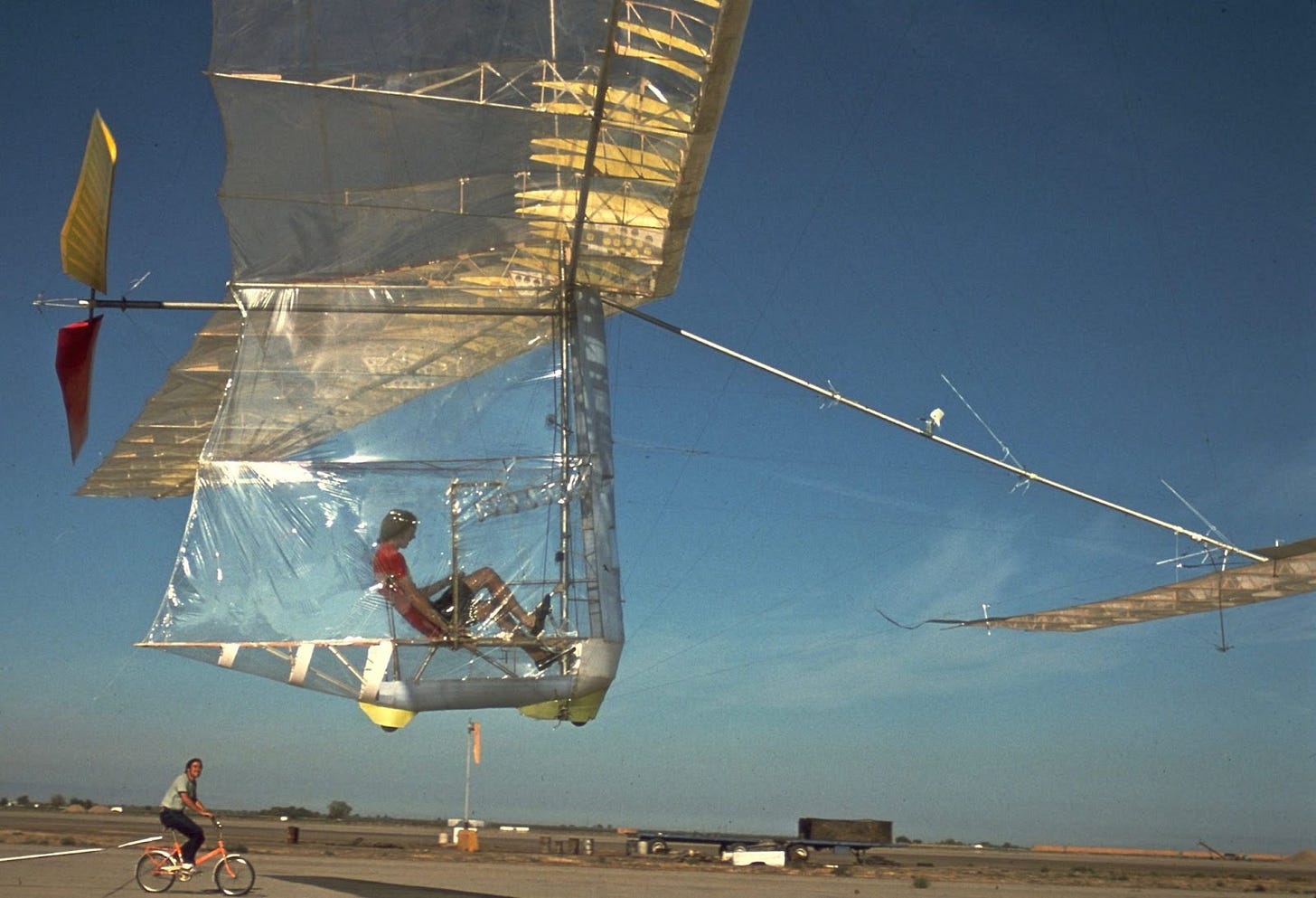The Gossamer Gap
A human-powered airplane. That was the challenge set forth by Henry Kremer in 1959. For 18 years, nobody could do it. But within six months of trying, Paul MacCready built and flew his Gossamer Condor (see below). The difference was in his approach: While others needed a year’s worth of effort for each test flight, he created a plane that he could fly, fix, and fly again in a matter of hours1.
The story of how MacCready won the prize is interesting. While other teams had more people, time, and resources, which enabled them to make sophisticated aircraft, that didn’t get them close to winning the prize. He said, “That proved that those approaches were not very good”. In fact, MacCready felt his inexperience and lack of resources was actually a strength. “Each other team had a specialist for every discipline, and so the wing structure was constructed starting from conventional structural design by an excellent structural engineer from the aircraft industry,” he said. “I have no background in aircraft wing structure. Thus, in my naiveté, I started from first principles (with some insights left over from building indoor model airplanes in the 50s and hang gliders in the early 70s), pretended I never saw an airplane before, and came up with the Gossamer Condor approach that permitted a 96’ span vehicle to weigh only 30 kilograms. The other engineers also knew about indoor models and hang gliders, but they knew so much about their specialty that an easier approach was not apparent.”
Now, a somewhat simple read of the story might lead us to the conclusion that the Gossamer Condor is yet another proof, and a particularly epic one, of the importance of combining naiveté, fast iterations and incremental design. And that interpretation would not be wrong, although there’s more than that: another edge of this story. First, ask yourself an important question: why aren’t we all pedaling through the air to our work every morning? Why aren't there hundreds of Gossamer Condor-like human-powered tiny airplanes parked outside railway stations in Amsterdam, Brussels or Buenos Aires? The Condor was just a rough prototype. It was unsafe, rudimentary and fragile, all inescapable traits of most prototypes out there. Prototypes are made only to prove something, make a point, and as quick and cheap as possible. Safety, compliance, ergonomics, are never part of the thinking process during prototyping, although they become essential during production.
MacCready and his team eventually improved the idea and designed the Gossamer Albatross, with which they aimed to cross the English Channel.
Early in the morning on June 12, 1979, amateur cyclist and pilot Bryan Allen powered the Albatross to the rehearsed speed of 75 revolutions per minute and took off from a point near Folkestone, England. The Channel conditions and lack of wind were ideal for the crossing.
However, problems soon began to affect the aircraft and pilot. Allen's radio failed for a while and he was only able to communicate with the accompanying boats by hand and head movements. In addition, Allen's water supply had been estimated for a two-hour flight, but headwinds delayed the crossing and his supply ran out. Without adequate water, Allen suffered from dehydration and leg cramps. Tell me about UX. With increasing headwinds, concern grew that the flight would have to be called off. With the coast of France still unseen, an accompanying boat maneuvered in front of the Albatross to hook it to safety. However, for the hooking procedure, Allen had gone a little higher and found less turbulence, so he continued to pedal the aircraft and see if progress could be made. With a calming surface wind, Allen continued, and landed on a beach at Cape Gris-Nez in France. Allen completed the roughly 36 kilometers crossing in 2 hours and 49 minutes, achieving a top speed of 30 km/h and an average altitude of 1.5 m.
The Albatross was an undeniable evolution of the Condor, but still it was nothing remotely near production level. Acknowledging the difficulty of human-powered flight, MacCready would eventually shift into solar-powered electric aircraft with the Penguin and then the Solar Challenger, early projects of what would then become AeroVironment.
Too many times we see prototypes dressed as products, but one thing is to come up with a rough strawman concept about something, and an absolute different story is to productize that into, well, a product. Products are things people—customers—pay for. And when it comes to mission-critical objects like aircraft, there are intricate liabilities, contracts and compliance involved. There are legal frameworks, fractal-like certifications (up from the system-level all the way down to the micro-component, software, third-party libraries and tools), safety regulations, environmental regulations.
The Gossamer Albatross involuntarily made a beautiful point when it struggled crossing the English Channel. Prototyping can help to prove a point, and it can be fun. But naiveté and rudimentariness will not provide enough thrust to cross an important gap—the gap between prototype and product which can only be named in one inescapable way: The Gossamer Gap.
https://signalvnoise.com/posts/2861-how-nature-and-naivet-helped-paul-maccready-build-a-human-powered-airplane-in-only-six-months

